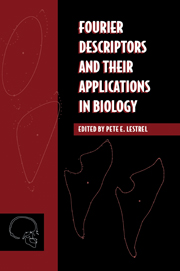Book contents
- Frontmatter
- Contents
- List of contributors
- Preface
- Acknowledgments
- Part one Theoretical considerations
- Part two Applications of Fourier descriptors
- 6 Closed-form Fourier analysis: A procedure for extraction of ecological information about foraminiferal test morphology
- 7 Fourier descriptors and shape differences: Studies on the upper vertebral column of the mouse
- 8 Application of the Fourier method on genetic studies of dentofacial morphology
- 9 Fourier analysis of size and shape changes in the Japanese skull
- 10 Craniofacial variability in the hominoidea
- 11 Heuristic adequacy of Fourier descriptors: Methodologic aspects and applications in Morphological
- 12 Analyzing human gait with Fourier descriptors
- 13 Elliptic Fourier descriptors of cell and nuclear shapes
- 14 Cranial base changes in shunt-treated hydrocephalics: Fourier descriptors
- 15 A numerical and visual approach for measuring the effects of functional appliance therapy: Fourier descriptors
- 16 Size and shape of the rabbit orbit: 3-D Fourier descriptors
- 17 From optical to computational Fourier transforms: The natural history of an investigation of the cancellous structure of bone
- 18 Epilogue: Fourier methods and shape analysis
- Appendix
- Glossary
- Index
8 - Application of the Fourier method on genetic studies of dentofacial morphology
Published online by Cambridge University Press: 14 September 2009
- Frontmatter
- Contents
- List of contributors
- Preface
- Acknowledgments
- Part one Theoretical considerations
- Part two Applications of Fourier descriptors
- 6 Closed-form Fourier analysis: A procedure for extraction of ecological information about foraminiferal test morphology
- 7 Fourier descriptors and shape differences: Studies on the upper vertebral column of the mouse
- 8 Application of the Fourier method on genetic studies of dentofacial morphology
- 9 Fourier analysis of size and shape changes in the Japanese skull
- 10 Craniofacial variability in the hominoidea
- 11 Heuristic adequacy of Fourier descriptors: Methodologic aspects and applications in Morphological
- 12 Analyzing human gait with Fourier descriptors
- 13 Elliptic Fourier descriptors of cell and nuclear shapes
- 14 Cranial base changes in shunt-treated hydrocephalics: Fourier descriptors
- 15 A numerical and visual approach for measuring the effects of functional appliance therapy: Fourier descriptors
- 16 Size and shape of the rabbit orbit: 3-D Fourier descriptors
- 17 From optical to computational Fourier transforms: The natural history of an investigation of the cancellous structure of bone
- 18 Epilogue: Fourier methods and shape analysis
- Appendix
- Glossary
- Index
Summary
Introduction
Quantifying the relative contributions of genetic and environmental influences on morphological variation in dental and facial structures is an important biological problem that continues to attract the interest of anatomists, physical anthropologists, geneticists, and clinicians in medicine and dentistry. Progress in this field has been limited for a number of reasons, including the: (1) complexity of craniofacial growth processes; (2) limited opportunities for experimental investigation in humans; (3) multifactorial mode of inheritance of dental and facial structures; and (4) significant methodological difficulties inherent in accurately describing the form of faces and teeth.
In the study of dentofacial variation, nonmetric, or qualitative, classifications may provide a satisfactory description of variations in shape, but these data cannot always be analyzed appropriately by the more powerful statistical methods. Conversely, metric methods based on combinations of linear and angular variables may provide reasonable representations of size, which are suitable for statistical analysis, but less appropriate for the description of shape variation.
Most genetic studies of dentofacial structures have relied on simple qualitative descriptors or on combinations of linear and angular variables to characterize morphology. These have been analyzed with the classical approaches of quantitative genetics, including twin and family studies, interpopulation comparisons, and the examination of individuals with chromosomal abnormalities.
- Type
- Chapter
- Information
- Fourier Descriptors and their Applications in Biology , pp. 189 - 209Publisher: Cambridge University PressPrint publication year: 1997
- 1
- Cited by



